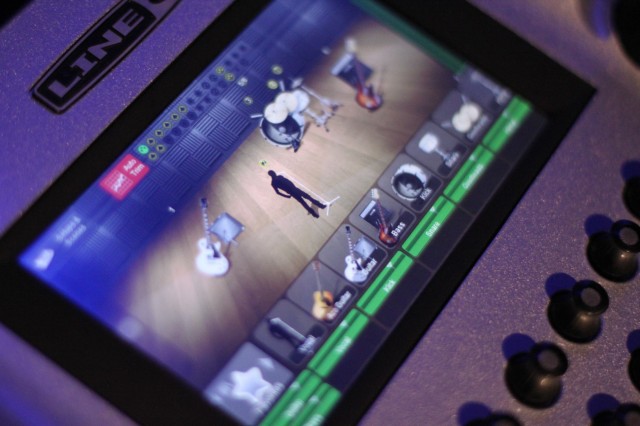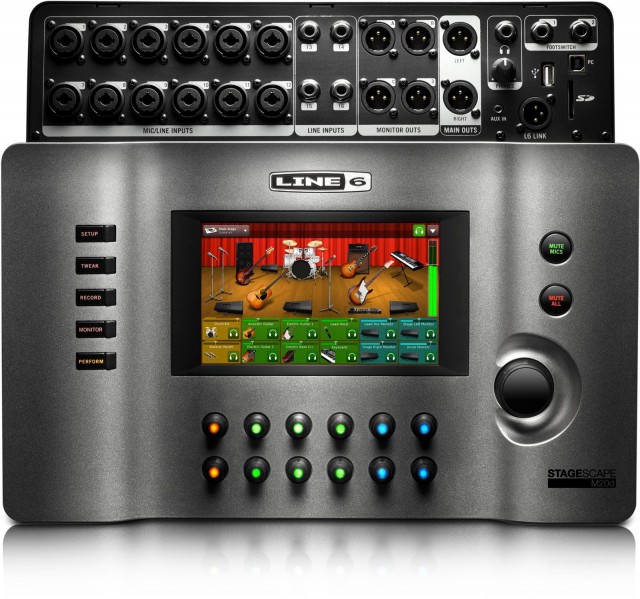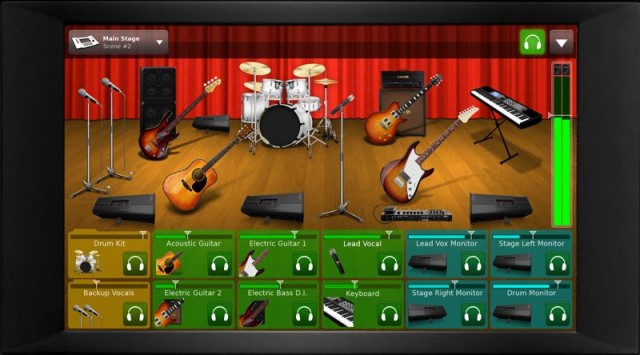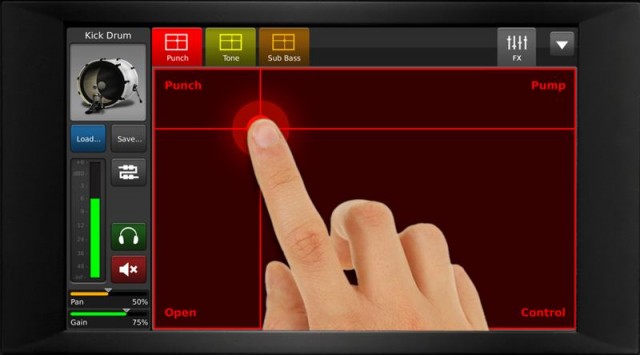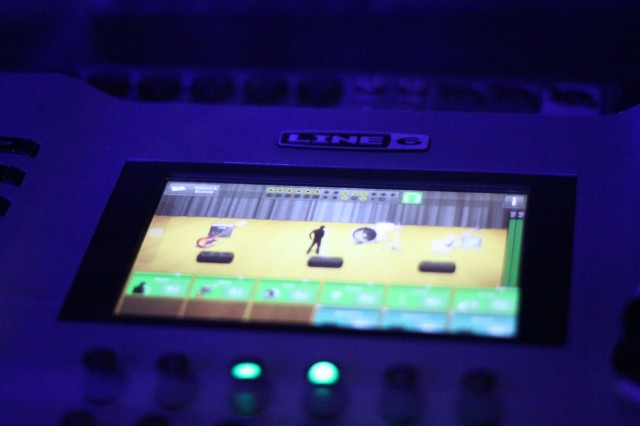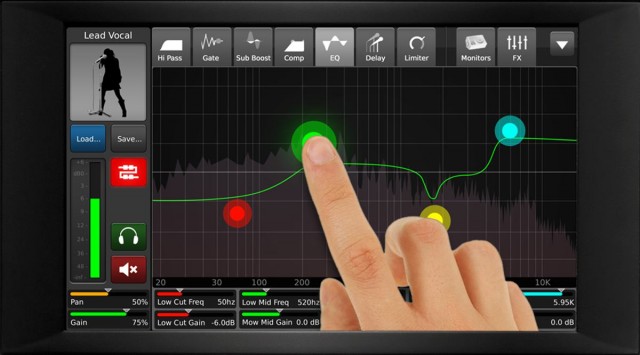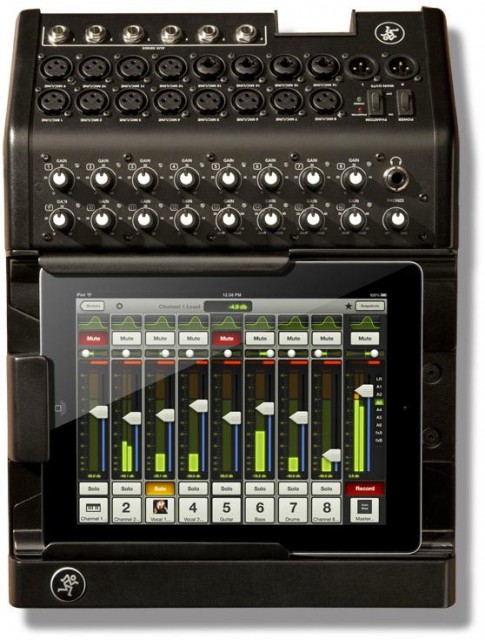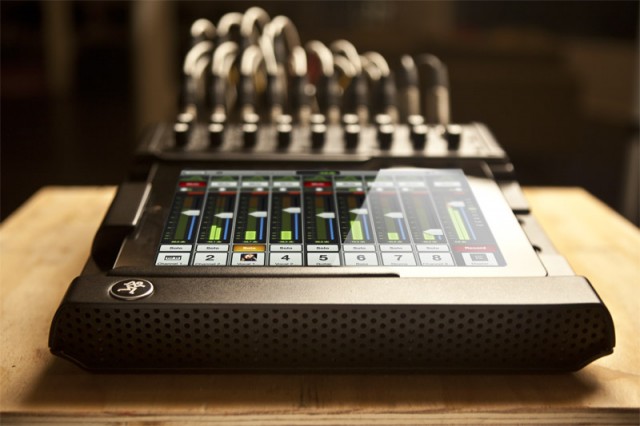Few things are as essential to music making as the experience of a live show. So it’s about time someone took some risks to see if there’s a better way to run live sound. Line 6’s new StageScape M20d is important because it does just that – it finally says the mixer as you know it doesn’t have to be sacred, and tries to build a better one. Traditionalists might be skeptical – and with good reason, as we see if this idea works in practice – but it features some bold ideas worth considering.
Centered on a touchscreen interface, the StageScape mixer eschews traditional channel strips in favor of images and virtual touch controls. Want to tweak your vocalist’s sound? Instead of remembering which channel she’s on, tap the picture of the singer. StageScape brings up an elaborate array of processing options, all performed behind the scenes by Line 6’s DSP tech. You can even store in internal memory twenty seconds of a band playing, then adjust multitrack audio after the fact until it’s right, wandering around a venue using an iPad as a remote control. From processing to preset settings, control to sound experience, StageScape is completely and totally digital. It even “knows” what kind of input you’re using when you plug in the jack.
The solution is radically different than what we’ve seen before. It’s likely to scare away some users, and we’ll have to see how it works in practice. But coupled with some sophisticated sonic capabilities, it just might win over new users and adventurous live sound vets. Here’s a first look, after CDM got to meet with Line 6 at the product’s unveiling.
A Better Mousetrap
For the most part, all mixers are designed with the same basic assumptions in mind. To connect multiple microphones and instruments, the mixer presents a series of columns that represent “channels,” and lines up parameters for each of those channels. To amplify and treat the sound of a singer, then, you connect the vocal microphone to a channel number, then adjust the settings for that particular channel. The challenge is, you are restricted to the knobs and faders on physical hardware, so anything you do is limited to a fixed number of controls – and you have to remember the abstraction of which instrumentalist is associated with which channel. Just writing this out seems redundant and obvious; we’re so used to the arrangement that it’s hard to even think about it. But if you do think about it, there is a layer of abstraction between what you’re doing and the way you’d think about the actual musical ensemble.
Adding a touchscreen interface means these kinds of abstractions don’t have to be there, but most software simply recreates the same setup. It may be easier to label channels once you have a display, but otherwise digital mixers have generally replicated the same setup. And even software has generally aped the lineup of channel strips, rather than design a visual metaphor more closely tied to how we think.
StageScape tosses all of that out the window.
It starts from the moment you plug in a cable. I/O jacks on the back, featuring combo Neutrik connectors, “know” what sort of cable you’ve connected. So, for instance, plug in an XLR, and the mixer guesses you’ve got a mic. Add a 1/4″ line jack, and it works out you’ve connected something that’s line level or instrumental. (I’m still researching just how much the auto-sensing considers, but it at the very least knows which connection you used.) The feature works with both input and output, and sets paramters like channel gain, EQ, effects and routing.
Live sound has already benefited from going digital. Having hung out front-of-house with the rival Avid Venue system, I can already tell you live sound engineers adore the change. Let’s assume you have a lineup of three bands. Already, the ability to label channels for those three different ensembles, set levels, and then store presets for instant-recall of settings for each is huge. In fact, I’d wager almost everyone reading this has been in a live situation – front-of-house, onstage, or both – where the show didn’t sound right because some setting from soundcheck was lost in translation. Digital presets are already a breakthrough.
What’s different with StageScape – apart from the fact that it’s far cheaper than something like Venue – is that the whole process is instantly focused on players, and it’s visual. Got a singer? You place a picture of the singer on a virtual stage on the screen, dragging their position in place with your finger. Got a guitarist? Drag a picture of a guitar. (Note that this view is called Perform Mode – you can also see more traditional views if that’s more convenient.)
The same graphical workflow applies to tweaking sound. X/Y pads take a bunch of DSP functions and label them in everyday English, so instead of adjusting a bunch of EQs and dynamic controls, you drag to settings like “punch” or “bright.” Line 6 emphasized that this will help folks who lack audio engineering backgrounds, but it might be useful to experienced users, too. Dynamics, equalization, and effects are also available as a separate, traditional “Deep Edit” view. Multiband compression and multi-point parametric EQ naturally benefit from touchscreen interfaces, since you can manipulate these graphical views directly. But you can also create your own X/Y presets, so when you need to make quick adjustments, you can quickly navigate favorite settings.
Of Touchscreens and iPads
It’s worth noting that the interface on the SoundScape mixer isn’t an iPad. Various vendors at the NAMM show last week had iPad dock solutions, but there’s an advantage to using a custom touchscreen. What’s wonderful about capacitive touchscreens (like the iPad and iPhone) is the instant response you get from a feathery touch. What’s terrible about capacitive touchscreens is that a feathery touch can quickly screw up your settings in a live show. That’s bad.
Line 6 joins a number of other music products in instead using a resistive screen. This technology requires some pressure before it senses your finger, which makes accidental touches less likely. It’s also less susceptible to, for instance, sweaty fingers.
Instead of making the iPad the main interface, Line 6 employs Apple’s tablet as a remote control. There, it makes far more sense than locked into a dock. You can wander around a venue and control the SoundScape mixing settings, hearing how they sound in different spots. (Especially useful: those 20 seconds of multitrack recording can be looped, as Line 6 showed off in a press conference featuring Colbie Cailet. It’s a simple thing to pull off, but so badly needed in live sound, it was met with enthusiastic cheers by the gathered crowd.) You do need an optional USB WiFi adapter to enable this functionality.
You’re also not without physical controls. Endless encoders, color-coded to match on-screen controls, provide physical, hands-on control. I don’t think anyone is going to like this arrangement quite as well as motorized faders (or faders, generally), but it does mean you get tangible control. (It’s also not hard to imagine Line 6 offering a motorized fader module if this box is a hit. In fact, I’d very much love to see a USB input on there, unless I missed one.)
Recording and Sound Processing
In addition to being a mixer, the SoundScape M20d is a multi-track recording device, so it can capture the same performance it’s mixing – perfect for preparing downloads of a live show. It records 24-bit lossless WAV to SD card or a connected USB drive or computer.
You also get various effects – no surprise with a Line 6 product – including:
- Parametric EQ
- Multi-band compression
- Feedback suppression
- Studio reverb
- Delays
- Vocal doubling
These in turn are bundled into channel effects.
I/O
While it eschews the channel strip metaphor, the M20d is otherwise a conventional mixer under the hood:
- 12 digitally-controlled mic/line combo ins (using that auto-sensing feature mentioned earlier)
- 2 digital inputs from computer, USB, or SD
- Stereo line inputs
- 4 monitor outs, 2 mains, each with auto-sensing on balanced XLR
Line 6 also has something called L6 LINK, a multi-channel, digital networked format via an XLR plug that allows you to connect and intelligently-configure Line 6’s own speakers. At NAMM, they were showing off their own StageSource speakers and subwoofer. They sounded terrific, though I am a little sad there isn’t a standard protocol employed on the mixer that would allow you to choose vendors.
What it’s Not
As part of the “let’s put an iPad in everything” trend at NAMM (which included almost everything but a harpsichord dock for your iPad), Mackie launched the DL1608.
In fact, the DL1608 basically is the Line 6, conceptually speaking, but minus all the critical refinements I mentioned – made more obvious when you look at images of these two units side by side.
- It immediately reproduces a virtual mixer screen on the touchscreen, which has the effect of demonstrating … why physical faders make more sense when you’re trying to reproduce physical faders.
- Using an iPad as a primary touchscreen saves some scratch, but then your iPad is stuck in your mixer, you have a capacitive touchscreen that can be too touchy when used live, and you have annoying things like notifications popping up while you’re trying to mix.
- You don’t get a fully-integrated system.
Correction: Like the Line 6 offering, the Mackie supports multiple iPads (up to ten) via wireless connection. Also like the Line 6 kit, you need extra hardware to support that — in the case of the Mackie, you need a connected router. I’m not sure with either how the mixer handles multiple people controlling the same parameters / how it deals with conflicts.
So, sorry. If I’m going to save money, I’ll just buy one of Mackie’s (excellent) non-touchscreen mixers. I think we have to see how touchscreens work for mixer in general, but if I were to go touch, the Line 6 product looks both more practical and better-equipped to actually innovate with the concept.
Mackie DL1608
Via SHOCKLEE blog
They do have a cute video, at least.
Stay Tuned
No official pricing or availability has been announced, but early numbers I heard made this sound accessible. Update: Street appears to be US$2500. That’s steep for the same band who’s just starting out and has no one doing sound (especially if they want to buy the PA, too), but it’s quite reasonable for people looking for a digitally-automated mixer for a home studio or live – and even more so given the DSP and touchscreen and iPad remote control options packed into this product.
To me, the big question will be who actually uses StageScape. Line 6 kept talking about bands who lack their own live sound person. But while the idea of a band running their own sound is appealing, that means the same band who couldn’t afford a tech now are buying and lugging around this PA system – possible in some cases, but surely not in all. Someone, it seems, is sure to buy it: venues, perhaps, and certainly academic and institutional settings where its user-friendly features are doubly valuable.
Once in place, we’ll see whether the “magical” interface can really replace a traditional mixer. I can certainly see some live sound people very badly missing the ability to hover their hands over physical faders. Oddly, the folks who might appreciate this most are the people who do live sound, and find its preset storage, built-in processing, and seamless configuration appealing in the field. I look forward to when we get to try it out.
But I applaud Line 6 for rethinking the mixing interface itself. The company certainly has a track record – co-founders Marcus Ryle and Michel Doidic gave us ADAT and then single-handedly popularized digital DSP for guitarists. We’ll see now if this is their third grand acheivement in transforming the business. In the meantime, this could easily be, amidst an avalanche of new gear, the most daring and promising new music product announcement this year.
